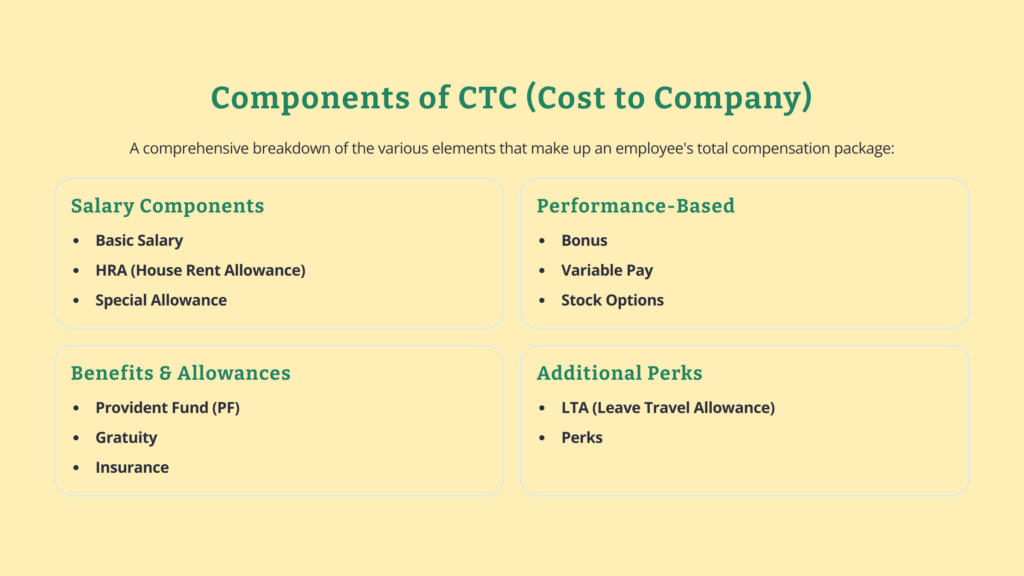
Quick Summary

One of the first questions asked during a job application is, “What is your current CTC?” To answer this effectively, it’s essential to understand what Cost to Company (CTC) means. Simply put, CTC represents the total compensation a company provides an employee, including base salary, bonuses, allowances, and benefits. In today’s competitive job market, mentioning current and expected CTC is crucial when negotiating salary expectations and presenting salary history. While many prefer discussing this towards the end of an interview, addressing it confidently early on can be beneficial in the hiring process.
CTC, or Cost to the Company, is the total amount a company spends on an employee annually, encompassing salary (gross salary, net salary, annual salary), benefits, bonuses, perks, etc. Understanding your current CTC is crucial for making informed career decisions, as it represents your overall compensation package from your prospective employer. Knowing your CTC helps you evaluate job offers, negotiate salary, and plan your finances effectively.
By clearly understanding your CTC, you can better assess whether a new job offer meets your salary expectations, financial needs, and career goals when discussing with your hiring manager. It also allows you to compare different job offers more accurately, ensuring you make the best decision for your professional growth ensuring you make the best decision for your professional development.

To calculate your CTC salary, you need to consider the following components:
By understanding the breakdown of your CTC, you can better evaluate your compensation package and make informed decisions about your career. This knowledge empowers you to negotiate effectively and ensure you receive fair and appropriate compensation.
I have researched and found that a fresher with my experience level can expect a CTC in the range of INR 2.5L to INR 5L per annum in India. This is my first full-time role, but I have worked as an intern, so I do not have a prior CTC as a fresher. As a fresher, clearly communicating your expected salary during job interviews is essential. I am open to discussing a salary package that aligns with my skills and job responsibilities. I am enthusiastic and believe in my potential to be valuable to the company.
My current cost to the company (CTC) is 12L per annum. After deductions, my basic salary is 6 lakhs, and the company provides additional allowances such as HRA, conveyance, and special allowances. I also receive performance incentives of 1-2 lakhs per annum and benefits such as health insurance, paid time off, and retirement benefits. While I am satisfied with my package, I am open to discussing any modifications based on the new job responsibilities. I would be happy to consider the salary range you have in mind for this role and work towards a mutually beneficial agreement.
My CTC is 15 lakhs annually, including fixed and variable components. The fixed component comprises a basic salary of 8 lakhs per annum and allowances such as HRA, conveyance, and medical reimbursements. The variable component includes performance incentives, which typically range between 2 to 3 lakhs annually. In addition to this, I also receive annual increments based on my performance and the company’s policies. It generally ranges from 12-18% per annum. While I am satisfied with my current package, I am open to discussing any adjustments based on the new job responsibilities and the company’s policies. I am open to discussing my expected salary based on the new job responsibilities and the company’s policies.
Though these are just samples, you need to focus on multiple aspects. Here are a few ways to help you gain the upper hand during salary negotiations.
CTC includes various components that an employee receives. Knowing them will help you answer the question better. Your answer should always be based on the fixed CTC.
The prominent components of your CTC are as follows:
An employee’s salary is usually divided into Fixed CTC and Variable CTC.
Fixed CTC components include the basic salary, PF, and gratuity. These are fixed amounts paid to the employee regardless of performance.
The main components under the fixed CTC (direct benefits) are:
Variable CTC means components like bonuses, allowances, and other benefits based on the employee’s performance and can vary from year to year.
The main components under variable CTC are:
In summary, fixed CTC components are consistent amounts, while variable CTC components are performance-based. The direct benefits come under fixed components, whereas indirect benefits come under variable CTC.
In-hand salary or net salary refers to the amount the employee receives after all the deductions are made from gross salary. It is essential to understand this amount clearly, as it is the amount you will receive in your bank account.
The fixed components of your salary structure, such as basic salary, provident fund (PF), gratuity, and other allowances, remain constant and form a part of your in-hand salary. On the other hand, variable components, such as bonuses, incentives, and other performance incentives, may vary depending on your performance and target achievements.
When you discuss compensation with the employer during your job interview, ensure you know about all the deductions and savings contributions. You are satisfied with the net salary amount that you will receive.
Apart from the salary, employees also receive various benefits such as health insurance, life insurance, and other perks. These benefits significantly add to the overall value of the compensation package, and it’s crucial to discuss them during the salary negotiation.
Discussing these benefits ensures you receive a comprehensive salary structure. It’s also important to consider the monetary value of the benefits, such as the premiums for medical insurance and the company’s contribution toward retirement plans. These benefits include a travel allowance as well.
Therefore, it’s essential to clearly understand the benefits package to make informed decisions about your compensation package. Factors such as market rates, savings, provident fund contributions, direct benefits, annual management bonuses, and indirect benefits will help during salary discussions.
To negotiate your salary package effectively, you must be aware of the current salary trends in your industry. Research the average salaries offered for your job role and experience level. This research will help you set a realistic expected salary during negotiations.
You can research salary information through online job boards, salary surveys, and industry associations. You can also network with professionals in your field to get an idea of the going rate for someone with your skills and experience.
Ensure to have realistic expectations during the negotiation process. Knowing the current salary trends can also help you identify the areas where you can negotiate effectively.
When discussing your current CTC, providing a clear and concise breakdown of your total compensation package is essential. Here’s a suggested structure for presenting your CTC:
By structuring your response this way, you can confidently and effectively communicate your current CTC to potential employers or recruiters and forward your expected cost to the Company. This approach demonstrates your professionalism and ensures that you present a comprehensive view of your total compensation package.

Current CTC means an employee’s total compensation package annually, including the base salary and allowances, bonuses, benefits, and other perks the employer provides. When you negotiate your expected CTC with recruiters, you might wonder why recruiters ask for current CTC. Recruiters consider this to understand your skills, experience, and market value. They also use it as a benchmark to determine whether your salary expectations are realistic.
Here are a few points that will help you understand how recruiters use your CTC to determine how to meet your expected current CTC salary:
It is used as a benchmark to understand your current level of compensation and use that as a starting point for negotiations.
It also helps to understand the affordability of your expected CTC per annum for the organization.
It can help you determine the appropriate salary range for your desired position.
It is a reference point to determine your market value and whether your expected CTC is realistic and reasonable.
Recruiters use your current CTC as a basis for negotiations and may ask for proof of salary and benefits to support your expectations.
Recruiters may use it to understand your past salary increments and use that information to decide on the increment to offer you.
It helps to understand the fit of your current compensation package to the role you are applying for. For example, suppose your current package is significantly higher than the new role offers. In that case, it indicates you are overqualified or unlikely to be satisfied with the new role.
Recruiters may also consider the company’s salary increments and structure policies. Some companies have fixed salary increments, while others may have a more flexible approach.
Note: Understanding your current CTC per annum helps you evaluate job offers and negotiate better salary packages.
In conclusion, Current CTC means monthly or yearly, depending on the context. Still, it typically refers to an employee’s total annual compensation, including base salary, bonuses, allowances, and benefits. Understanding your current CTC is crucial for navigating salary discussions, evaluating job offers, and making informed career decisions. It’s not just about the base salary; knowing the full breakdown, including allowances, bonuses, benefits, and other perks, empowers you to effectively negotiate and align your compensation expectations with your career goals. By communicating your CTC confidently and transparently, you can secure a compensation package reflecting your skills, experience, and value in the job market.
Ans. Answer your current salary honestly. For Example: “My current CTC is 5 lakhs per annum, including base salary, bonuses, & other benefits. I’m open to discussing my compensation in detail if you’d like, and I’m interested in understanding how this role aligns with my career goals and expectations.”
Ans. To find your current CTC, check your salary slip or offer letter. It should include detailed information about your basic salary, net salary, allowances, bonuses, and other benefits. You can also ask your HR department for a detailed CTC breakdown.
Ans. Example: “I’m seeking a CTC in the 10 lakhs per annum range based on my skills, experience, and market rates. I’m open to discussing this further and exploring how it aligns with the role and the company’s compensation structure.”
Ans. CTC for a ₹25,000 monthly salary can be calculated by including all additional benefits and allowances provided by the employer. For example, if your basic salary is ₹25,000 and you receive other benefits like HRA, medical allowance, etc., your annual CTC will be higher than ₹3,00,000.
Ans. CTC usually refers to the total annual cost to the company. While some components might be paid monthly, the CTC itself is an annual figure that includes all yearly expenses related to an employee.
A 4% salary increase means a 4 percent boost to your current salary. To calculate this, multiply your existing salary by 0.04 (the decimal form of 4 percent). Then, add this value to your original salary to determine your new salary after the 4% raise.
A CTC of 4.5 lakh means a total annual compensation of ₹4.5 lakh, including base salary, allowances, bonuses, and benefits. It is the gross amount the company spends on you per year before any deductions.
PF (Provident Fund) is a retirement savings plan where both the employee and employer contribute a percentage of the employee’s basic salary. In India, the EPF scheme helps employees save for retirement, with both contributions earning interest over time.

Authored by, Amay Mathur | Senior Editor




Amay Mathur is a business news reporter at Chegg.com. He previously worked for PCMag, Business Insider, The Messenger, and ZDNET as a reporter and copyeditor. His areas of coverage encompass tech, business, strategy, finance, and even space. He is a Columbia University graduate.
Editor's Recommendations
Chegg India does not ask for money to offer any opportunity with the company. We request you to be vigilant before sharing your personal and financial information with any third party. Beware of fraudulent activities claiming affiliation with our company and promising monetary rewards or benefits. Chegg India shall not be responsible for any losses resulting from such activities.
Chegg India does not ask for money to offer any opportunity with the company. We request you to be vigilant before sharing your personal and financial information with any third party. Beware of fraudulent activities claiming affiliation with our company and promising monetary rewards or benefits. Chegg India shall not be responsible for any losses resulting from such activities.